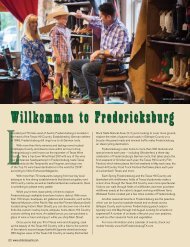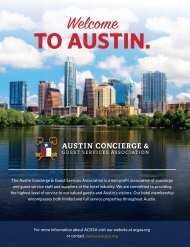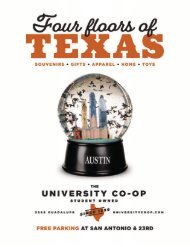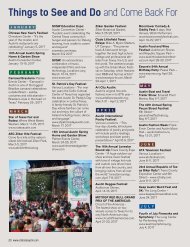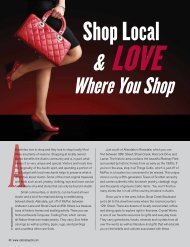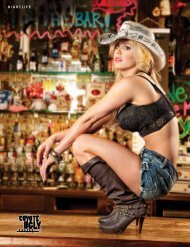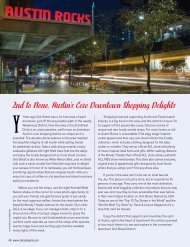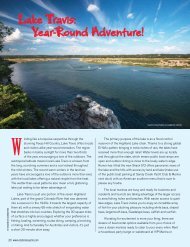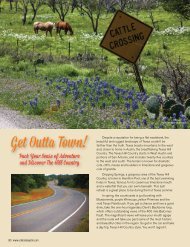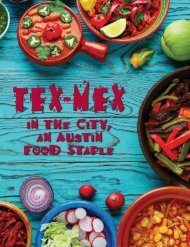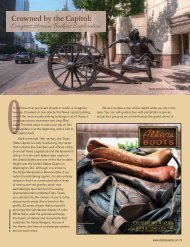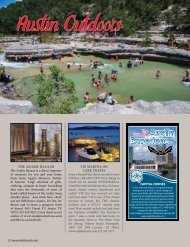CelebrateAustin_2017_SixthStreet_LR
You also want an ePaper? Increase the reach of your titles
YUMPU automatically turns print PDFs into web optimized ePapers that Google loves.
photo courtesy of herron stock<br />
Historic Austin,<br />
Modern Day Entertainment<br />
by shannon barrientes<br />
K<br />
nown nationwide as a music and entertainment<br />
hotspot, Sixth Street is inarguably one of the<br />
most bustling and exciting streets in all of Austin.<br />
Most weekend evenings (and some holiday and<br />
special events) traffic is blocked in the area,<br />
allowing unencumbered pedestrian traffic to traverse<br />
the hurried area. Park on the nearby outskirts and take<br />
a pedicab to this exciting entertainment district to see<br />
live music any night of the week, and to enjoy a cold<br />
cocktail and some local dining.<br />
Though legendary for the music scene, this area also<br />
boasts a deep-rooted history that is integral to the core<br />
of what makes Austin special to this very day. Historically,<br />
the most significant part of this street extends from the<br />
celebrated Driskill Hotel at the corner of Brazos Street<br />
and continues six city blocks to I-35. This portion was<br />
once served as a major thoroughfare through the inner-city<br />
area. In the mid-nineteenth century, Sixth Street was<br />
Pecan Street, and it served as a stagecoach route for<br />
travelers. Edwin Waller, elected as the city’s first mayor<br />
in 1840, engineered a grid plan for the streets of the<br />
city; most of this grid plan is still intact as modern<br />
downtown Austin.<br />
Pecan Street was the choice traveling route into<br />
town for the farmland communities to the east, and soon<br />
became a major commerce district. Before the American<br />
Civil War, Sixth Street was bustling with stores, saloons<br />
and hotels. Many of those original buildings are still<br />
standing and today house bars, venues and entertainment.<br />
You can see evidence of this early history by visiting the<br />
Missouri House, erected in 1861 and still standing at the<br />
corner of Brazos and Sixth. It was Austin’s first boarding<br />
home for travelers on their way to the Wild West, but<br />
today you can enjoy a cold beer and a round of pool with<br />
your friends in two levels of the building.<br />
After the Civil War, the area welcomed the railroad<br />
and the area boomed – inviting in fashion retail, offices,<br />
showrooms and warehouses that catered to travelers and<br />
locals. One of these retailers, Scarbrough and Hicks<br />
department store, is responsible for erecting the Scarbrough<br />
Building in 1910, Austin’s first skyscraper at eight<br />
stories tall, and is to this day a beautiful example of the<br />
Commercial style of the early twentieth century.<br />
Just down the street, stop in at Iron Cactus to enjoy<br />
tableside guacamole and an icy margarita. Be sure to<br />
take in the epic views of Sixth Street from their rooftop.<br />
In the summertime, their rooftops misters will refresh you<br />
for a night on the town.
6TH. STREET<br />
The oldest bar on Sixth Street is locally<br />
owned Maggie Mae’s, which has stood<br />
proud for 39 years, and is an Austin<br />
institution. It is located in four beautifully<br />
restored buildings erected circa 1850s.<br />
Maggie Mae’s features an authentic New<br />
Orleans-style courtyard with a staircase<br />
that extends to a 5,000 square foot rooftop<br />
deck that allows for a gorgeous view<br />
of downtown Austin. Dedicated to Gibson<br />
USA, the roof features a brand-new stage<br />
equipped with premium digital sound.<br />
Upstairs you will also discover the Gibson<br />
Guitar Room and Les Paul Lounge, celebrating<br />
the life and accomplishments of Les Paul<br />
(1915–2009). Also nestled inside is the<br />
newly renovated Legacy Lounge featuring<br />
a wall-sized mural by Robert Hurst and an<br />
authentic English pub with Guinness on<br />
draft. At Maggie Mae’s, you can find live<br />
music seven nights a week.<br />
Just a few blocks over is Bobalu Cigar<br />
Company – be sure to stop in and watch live<br />
cigar rollers in the ancient and beautiful<br />
art form that is cigar rolling. You can watch<br />
through a window from the street as<br />
trained professionals make custom cigars<br />
for a waiting line of locals and visitors.<br />
This renowned shop also carries a fantastic<br />
selection of unique and imported cases<br />
and accessories, as well as a liberally<br />
stocked humidor. They will hand-roll a cigar<br />
for you by request and it’s an experience<br />
you won’t soon forget.<br />
The history of Austin is alive on Sixth<br />
Street and is remembered bi-annually via<br />
the Austin Pecan Street Festival, every May<br />
and September. The festival is in its fortieth<br />
year of celebration, and the festivities<br />
represent so much of what makes Austin<br />
unforgettable: multiple stages for live music,<br />
art and dance performances, craft booths<br />
populated with local artisans and street<br />
food vendors, and lots of fun for the kids at<br />
the petting zoo.<br />
There are countless hidden treasures<br />
along this wonderful corridor that make up<br />
the heart of Austin. Don’t miss the daytime<br />
opportunities that abound in the form<br />
of shopping, retail and, for the historically<br />
inclined, the beautiful monuments that<br />
stretch from the legendary Driskill Hotel<br />
and on toward I-35. For those of you who<br />
love the nightlife, you are headed in the<br />
right direction.<br />
Did You Know?<br />
All of the artwork in the Driskill Hotel is original, but there are no<br />
records of how they were acquired or who the artists are.<br />
Louis Armstrong made his Texas debut at the Driskill Bar in 1931.<br />
There’s a “historic” side of the building and a newer side<br />
of the building. The newer side, added in the 1920s,<br />
features narrower passageways as women no longer<br />
wore hoop skirts and didn’t need as wide of walkways.<br />
Helen Corbitt was a chef at the Driskill, developing her<br />
famous cheese soup there, before going to Neiman Marcus<br />
in 1955 to be the director of food services.<br />
The portrait of Jesse Driskill on the staircase has a few<br />
dents in it from the time when two lawyers got into a violent<br />
argument in the lobby, and a stray bullet hit the painting.<br />
The Texas Rangers met in the Jim Hogg room in 1934 to devise<br />
a plan to finally bring down the infamous duo of Bonnie and Clyde.<br />
www.celebrateaustin.com | 35



